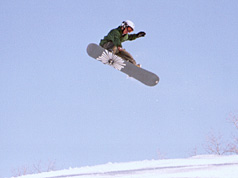
Snow Boarding Head Injuries Increase; AANS: Wear a Helmet
Because it is high season for winter sports, the American Association of Neurological Surgeons offers this timely advice: proceed with caution, wear a helmet, and play it safe on the slopes and snow. Every year, thousands of adults and children are treated at U.S. hospital emergency rooms for head injuries related to winter sports, the group reminds us. According to the U.S Consumer Product Safety Commission, snow boarding's gain in popularity in recent years has been paralleled by an increase in the number of head injuries snow boarders have suffered. The commission's most recent head injury statistic estimates from 2006 related to winter sports tally the head injuries by activity as follows:
--Snow Boarding: 6,326
--Ice Hockey: 5,263
--Snow Skiing: 4,922
--Ice Skating: 2,924
--Sleds, Snow Disks and Toboggans: 2,142
--Snowmobiles: 301
Head injuries tend to be most serious and result in fatalities from skiing and snowmobile accidents. While the number of skiing-related head injuries has remained about the same, the good news is that the number of snowmobile-related head injuries has decreased considerably in the last two years. The majority of ice hockey and skating accidents result in concussions or contusions. While many organized hockey team players wear helmets, concussions can still occur. However, it is important to remember that helmets worn in conjunction with all winter sports may help prevent far more devastating consequences.
According to the AANS, many head injuries can be avoided by following these simple safety precautions:
- Buy and use helmets or protective head gear approved by the ASTM for specific sports 100 percent of the time.
- Wear appropriate clothing for the sport.
- Do not participate in sports when you are ill, very tired, or have consumed alcohol.
- Do not participate in outdoor sports when weather conditions pose a serious hazard.
- Drive snowmobiles slowly and only on marked trails.
- Ice skate only in areas designated for skating, and be sure to check the ice for cracks and debris.
- Use only sleds that can be steered, and never go down a slope head first.
- Follow all posted signs and warnings on ski slopes, sledding hills and ice skating rinks.
For more information and free downloadable fact sheets on injury prevention, visit http://www.NeurosurgeryToday.org, and choose "Patient Safety Tips."